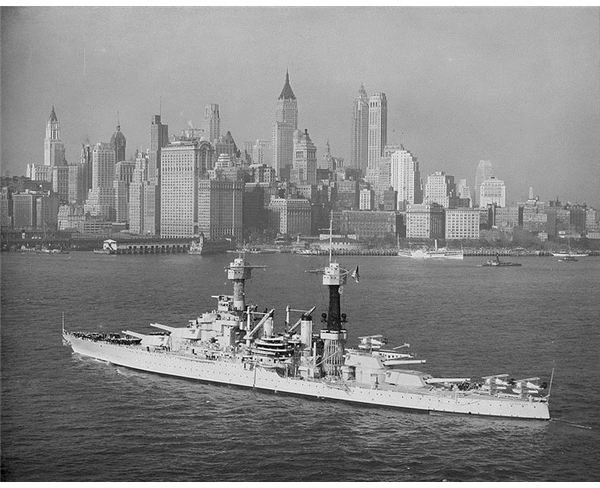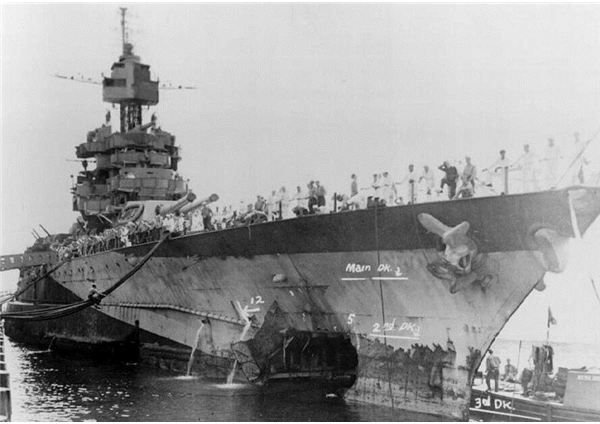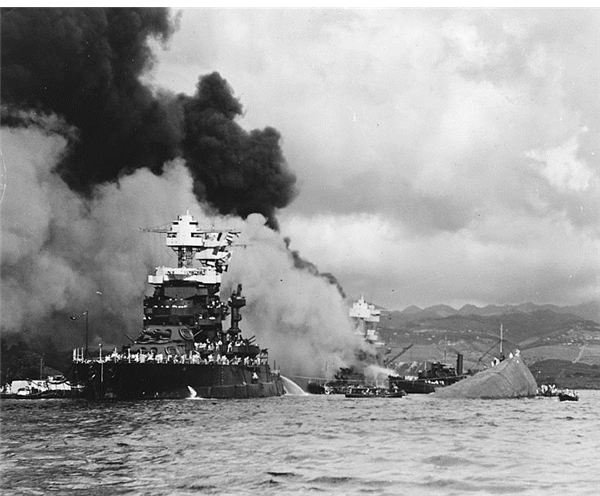The USS Maryland: Battleship, Grey Color, 16" Guns, and a Member of the Colorado Class
The Pride of the 1930s Fleet: USS Maryland and the Colorado Class Battleships
The USS Maryland and her two sisters, the USS Colorado and USS West Virginia, held the distinction throughout the 1930s as the pinnacle of American naval might. Due to the limitations imposed by the Washington Naval Treaty these three members of the Colorado Class of battleships were the last of that type to be built for the US Navy until World War II was on the immediate horizon. Sporting eight 16" naval guns in four twin turrets, these battleships, and especially the Maryland, were to play a key role in the course of the Pacific War.
Maryland was designed to be part of a firing line composed of similarly handling and armed battleships. After assessing the performance of battle fleets in the First World War the US Navy decided to build a force capable of fighting as one large, cohesive unit. Admirals of history have often been forced to divide their command into fast and slow wings due to the varying speeds of the ships they possessed, and yet still coordinate their charges during the middle of a firefight. As can be imagined, trying to coordinate anything when explosive shells more than a foot in diameter are falling all around is no simple feat. So the US decided to avoid this problem by simply designing all battleships built in the 1920s along similar lines.
Of those completed before the curtailment of warship production in the 1930s, the Colorado Class was the last and best expression of this ideal. Armed with a proven main gun system and incorporating lessons learned from each preceding battleship class, they were the pride of the fleet and held to be equal to anything any other navy could field. And of the three, USS Maryland was destined to be arguably the most famous.
USS Maryland: A Class Unto Herself?
In fact, due to her unique appearance during the Second World War and her reputation within the fleet, the Maryland, or even a sister ship, may sometimes be mistakenly referred to as a Maryland Class battleship. Though this is not their official designation and Maryland herself was not designed differently than her sisters, simple necessity throughout her life dictated a slightly different upgrade path relative to her sisters.
As constructed, Maryland exemplified post World War I thinking in battleship design. Her main armament was comprised of big 16" guns (larger weapons than those fielded on most European battleships) and she was well protected in any area of her hull or superstructure that housed critical functions. She was liberally armed with a smattering of secondary 5" guns which were meant to ward off torpedo boats and destroyers, or to simply harass larger ships by dropping mid-sized shells onto their less protected parts during a battle.
Weighing in at just over 32,000 tons as constructed, Maryland could attain a top speed of about 21 knots and cruise for thousands of miles without refueling. She was more than 600 feet long, almost 100 feet wide, and required at least 31 feet of depth in order to avoid grounding. Crewed by around a thousand sailors, Maryland was an excellent blend of firepower, mobility, and protection meant to engage the navy of Japan in the western Pacific during the early days of any conflict in that region.
Of course, this configuration did not last throughout her career. Although a highly modern warship when commissioned in 1921, by the outbreak of World War II in 1939, many of her components were outmoded and significant assumptions that had been made and that influenced her design were hopelessly outdated. Particularly, her anti-aircraft armament was woefully inadequate to handle the airborne threats that were developing throughout the 1930s. And it was to be Japanese aircraft, not Japanese battleships, that would pose the greatest hazard to her survival.
The Maryland and Pearl Harbor
Maryland was one of eight battleships present in their dour, battleship grey color camouflage scheme at the US Navy anchorage in Pearl Harbor on the morning of December 7, 1941. In a strike that would go a long way towards establishing the aircraft carrier as the queen of the seas, not to mention throw American pre-war plans to the four winds, the US Pacific Fleet was crippled and every battleship docked in Pearl Harbor damaged or sunk.
More than three hundred carrier aircraft armed with torpedoes and bombs tore into the pride of the US Navy, and before the day was done the USS Arizona had taken a bomb to her magazines and blown up, the USS Oklahoma suffered numerous torpedo hits that capsized her, USS California had sunk, USS Nevada had been beached to avoid sinking, and Maryland’s sister, West Virginia, had been sent to the bottom as well.
Maryland herself got away with relatively minor damage - she benefited from being tied up inboard of Oklahoma and this protected her from torpedo hits. Her anti-aircraft batteries, such as they were, were brought into action relatively quickly and she helped down some of the few Japanese airplanes to be destroyed that day. But though she was well protected from torpedoes, two bombs struck her and caused serious damage to her superstructure. Good damage control kept her fighting, and in the aftermath of the attack she was one of the ships able to send damage control parties to assist other damaged vessels.
The catastrophic defeat of Pearl Harbor did offer an upside for Maryland. Damaged to the point that she needed a couple months of repair in a fully equipped naval yard, she escaped relatively unscathed relative to the Arizona, Oklahoma, or even her sister West Virginia. Though the latter was eventually raised from the bottom of Pearl Harbor, hastily patched up, and sent to Seattle for reconstruction, she did not return to service until mid-1944. Maryland, by contrast, was back in action by March of 1942- even after she had been significantly refitted to better cope with the demands of the Pacific Fleet.
The War Record of the USS Maryland
Her partial reconstruction provides the best case for her mistaken classification as a Maryland class battleship: after her repair and update she effectively became a class of her own. After Pearl Harbor, Maryland was never very similar to either of her sisters ever again. Colorado had been undergoing renovation when the war broke out, but this was cut short due to the desperate need of the US Navy at the time. West Virginia was almost entirely rebuilt during the two years she spent stateside and ended up resembling battleships of other classes far more than her original sisters.
But Maryland’s three months in the yard was sufficient to let her be modified more extensively than Colorado, and less so than West Virginia. She received a boosted anti-aircraft armament of 40 mm and 20 mm autocannons and replaced the old barbette style mounts for her 5" guns with dual purpose twin turrets similar to those that would soon be mounted on new destroyers. Her superstructure was changed and her battleship grey color scheme was altered to reflect the conditions prevalent in the battles of the Pacific War- battles that would involve her dodging attacks by aircraft more frequently than plunging fire from enemy battleships.
She was soon put to work as a reserve force for the carriers, standing by at the Battle of Midway to fight in a last ditch effort to hold the island if things went badly during the epic carrier battle. She provided her greatest contribution, however, as a floating artillery support platform during the bloody invasions of Tarawa, Palau, the Philippines, and Okinawa. She fought through bomb strikes and had her bow torn open by an aerial torpedo during the course of these engagements. As a shore bombardment vessel she provided vital covering fire for US Marines and Army personnel trying to fight their way inland on key islands held by the Japanese.
In addition, Maryland was one of the battleships present at the Battle of Leyte Gulf, and added her firepower to the other battleships tasked with protecting the transports that at the time were debarking men and equipment to retake the Philippines. A Japanese naval force led by two battleships forced their way into the Surigao Strait in hopes of destroying these transports, and there encountered an American battle line of six battleships - five of which had been damaged at Pearl Harbor. Together they inflicted a crushing defeat on the Japanese in the last battleship vs battleship engagement in history.
Maryland was obsolete by the end of the war, and ended her career transporting American personnel home over the Pacific. Less than two years after repatriating around 8000 of these personnel, Maryland was stricken and broken up for scrap metal.
Images



References
- George Sullivan: The Day Pearl Harbor Was Bombed, 1991 Scholastic Inc
- Robert C. Stern: U.S. Battleships in Action, Part 1, 1980 Squadron/Signal Publications
- All images courtesy of the United States Navy, accessed via Wiki Commons
- Janes Fighting Ships of World War II, 1946 Janes Publishing Company, 1994 reprint edition
- Arthur Zich, The Rising Sun, 1977 Time Life Books
